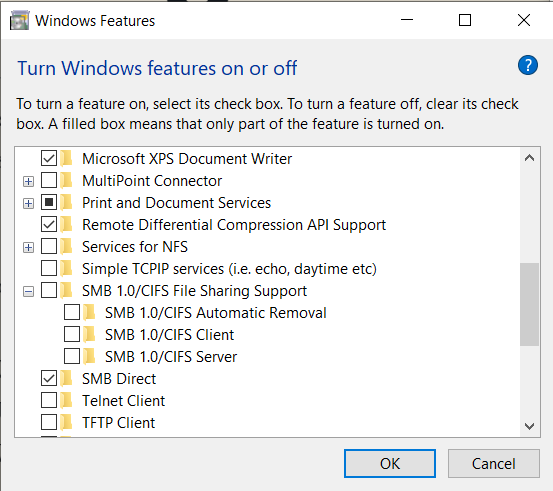
Connect To Samba Windows 7 Client Has
Configuring a full DNS server is out of the scope of this article, so I edited the /etc/hosts file of every CentOS 7 machine and added the following line there. Otherwise, Samba may fail to start. Configuring DNS for Samba Server: Before you get started, make sure your DNS server is configured correctly. These computers are in the same network 10.0.1.0/24. The Samba Windows 7 Client has the IP address 10.0.1.12.

In Windows 10 Home and Pro 1709, these changes are not applied and the network access under the guest account is working fine.If you try to access a network shared folder using the SMB v2 protocol under the guest account, the following error appears in the SMB client log (Microsoft-Windows-SMBClient): Source: Microsoft-Windows-SMBClientIn most cases you can face this problem when accessing old NAS devices (usually guest access is enabled on them for ease of setup) or when opening network folders on Windows 7/2008 R2/Windows XP/2003 with the anonymous (guest) access configured.In this case, Microsoft recommends changing the settings on a remote computer or NAS device that hosts the network folders. When accessing a network folder under a guest account over the SMBv1/v2 protocol, such methods of traffic protection as SMB signing and encryption are not used, which makes your session vulnerable to the MiTM (man-in-the-middle) attacks. Guest (anonymous) means access to a shared network folder without authentication. The point is that in modern versions of Windows 10 (starting from 1709 build), the guest access to the shared folders using the SMBv2 protocol is disabled by default. These policies help protect your PC from unsafe or malicious devices on the network.Moreover, on other computers with Windows 8.1, Windows 7, or on Windows 10 with a build of up to 1709, the same shared network folders open normally.
Connect To Samba Password Protection Via
In Windows, you can enable sharing of network folders and printers with password protection via the Control Panel -> Network and Sharing Center -> Advanced sharing settings. Samba server on Linux — if you are sharing network folder using Samba on Linux, add the following string to the smb.conf configuration file under the section : map to guest = neverAnd restrict anonymous access in the section with a description of the shared folder: guest ok = no NAS devices – disable guest access in the settings of your NAS device (depending on model) This is the most correct and safest way to fix the problem.Depending on the device on which network folders are stored, you must disable guest access on them: Or configure access with authentication if only the SMBv2 protocol is supported by the device.

However, you should understand that using this workaround is not recommended, because this reduces the level of protection for your system. Do not enable the SMB1Protocol-Server feature if your computer is not used by legacy clients as a shared folder SMB server.After installing the SMBv1 client, you should be able to connect to a shared folder or printer without any problems. In this case, you should try to reconfigure the remote SMB device to use at least SMBv2 (the correct and safe way).If you use Samba server on Linux to share network folders, you can specify the minimum supported version of SMB protocol in the smb.conf file like this: On Windows 7/Windows Server 2008 R2, you can disable the SMB 1 protocol and enable SMBv2 with the following PowerShell commands:Set-ItemProperty -Path "HKLM:\SYSTEM\CurrentControlSet\Services\LanmanServer\Parameters" SMB1 -Type DWORD -Value 0 –ForceSet-ItemProperty -Path "HKLM:\SYSTEM\CurrentControlSet\Services\LanmanServer\Parameters" SMB2 -Type DWORD -Value 1 –ForceOn Windows 8.1/Windows Server 2012 R2, you can disable SMBv1, enable SMBv2 and SMBv3, with the following command (verify that a private or domain profile is used for your network connection):Disable-WindowsOptionalFeature -Online -FeatureName "SMB1Protocol"Set-SmbServerConfiguration –EnableSMB2Protocol $trueIf your network device (NAS, Windows XP, Windows Server 2003) supports only the SMB1 protocol, you can enable a separate SMB1Protocol-Client feature on Windows 10. But this is not recommended.Run the PowerShell prompt and verify that the SMB1Protocol-Client is disabled (State: Disabled):Get-WindowsOptionalFeature -Online -FeatureName SMB1Protocol-ClientEnable the SMBv1 client protocol (a reboot is required):Enable-WindowsOptionalFeature -Online -FeatureName SMB1Protocol-ClientYou can also enable/disable additional features of Windows 10 (including SMBv1 components) from the dialog optionalfeatures.exe -> SMB 1.0/CIFS File Sharing Support.On Windand newer, the SMBv1 client is automatically deleted if it has not been used for more than 15 days (the SMB 1.0/CIFS Automatic Removal feature is responsible for this).In this example, I enabled only the SMBv1 client.


 0 kommentar(er)
0 kommentar(er)
